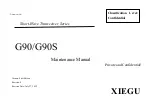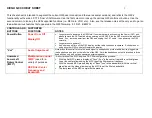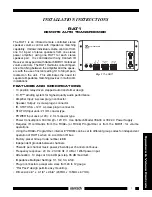
GUIDE TO INSTALLATION AND OPERATION
FXE-1501 |
5
3 Operation
3.1 Control options
The FXE-1501 can be controlled in two different ways:
•
The local control panel and its push-buttons can be used to move through a menu of parameters and to adjust a
basic set of parameters (see section 3.3).
•
Miranda’s iControl system can be used to access the card’s operating parameters from a remote computer, using
a convenient graphical user interface (GUI) (see section 3.4).
3.2 Card-Edge Status LED
The status monitor LED is located on the front card-edge of the FXE-1501, and is visible through the front access door
of the DENSITÉ frame. This multi-color LED indicates the status of the FXE-1501 by color, and by flashing/steady
illumination.
The chart shows how the various error conditions that can be flagged on the FXE-1501 affect the LED status.
•
If a cell is gray, the error condition cannot cause the LED to assume that status
•
If more than one LED status is possible for a particular error condition, the status is configurable.
See Annex 1 on page 17 for details.
•
The factory default status is shown by a
The LED will always show the most severe detected error status that it is configured to display, and in the chart error
severity increases from left to right, with green representing no error/disabled, and flashing red the most severe error.
LED Status
Error Condition
Green
Yellow
Red
Flashing
Red
No errors
No UTP Link
No Fiber Link
No Fiber Module
No Rear
If the LED is Flashing Yellow, it means that the card is selected for local control using the Densité frame’s control
panel, or that the card is booting up. See Section 3.3 for details.
3.3 Local control using the Densité frame control panel
3.3.1 Overview
Push the SELECT button on the FXE-1501 card edge (see Section 1.4) to assign the local control panel to operate
the FXE-1501. Use the control panel buttons to navigate through the menu, as described below.
All of the cards installed in a Densité frame are connected to the frame’s controller card, which handles all interaction
between the cards and the outside world. There are no operating controls located on the cards themselves. The
controller supports remote operation via its Ethernet ports, and local operation using its integrated control panel.









































